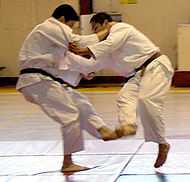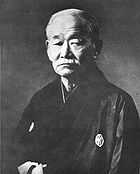Judo
| |||||||
| |
Subject classification: this is a sports resource . |
Judo (柔道 jūdō, meaning "gentle way") is a modern Japanese martial art and Olympic sport created in Japan in 1882 by Jigoro Kano (嘉納治五郎). Its most prominent feature is its competitive element, where the objective is to either throw or takedown an opponent to the ground, immobilize or otherwise subdue an opponent with a pin, or force an opponent to submit with a joint lock or a choke. Strikes and thrusts by hands and feet as well as weapons defenses are a part of judo, but only in pre-arranged forms (kata, 形) and are not allowed in judo competition or free practice (randori, 乱取り). A judo practitioner is called a judoka.
The philosophy and subsequent pedagogy developed for judo became the model for other modern Japanese martial arts that developed from traditional schools. The worldwide spread of judo has led to the development of a number of offshoots such as sambo and jiujitsu.

History and philosophy
Early life of the founder

The early history of judo is inseparable from its founder, Japanese educator Jigoro Kano (嘉納 治五郎 Kanō Jigorō, 1860–1938). Kano was born into a relatively affluent family. He married Sadako Kano, daughter of the owner of Kiku-Masamune sake brewing company, changed his name to Kano and ultimately became an official in the local government.[1]
Jigoro Kano had an academic upbringing and, from the age of seven, he studied English, Japanese calligraphy and the Four Confucian Texts under a number of tutors.[2] When he was fourteen, Kano began boarding at an English-medium school in Shiba, Tokyo. The culture of bullying endemic at this school was the catalyst that caused Kano to seek out a Jujutsu training place.[2]
Early attempts to find a jujutsu teacher who was willing to take him on met with little success. Many of those who had once taught the art had been forced out of teaching or become so disillusioned with it that they had simply given up. Nakai Umenari, an acquaintance of Kanō's father and a former soldier, agreed to show him kata, but not to teach him. The caretaker of his father's second house, Katagiri Ryuji, also knew jujutsu, but would not teach it as he believed it was no longer of practical use.[3] Several years passed before he finally found a willing teacher.[3]
In 1877, as a student at the Tokyo-Kaisei school (soon to become part of the newly founded Tokyo Imperial University), Kano learned that many jujutsu teachers had been forced to pursue alternative careers.[4] After inquiring at a number of these, Kano was referred to Fukuda Hachinosuke,[5] a teacher of jujutsu, who had a small nine mat dojo where he taught five students.[6] Fukuda is said to have emphasized technique over formal exercise, sowing the seeds of Kano's emphasis on randori free practice in judo.
On Fukuda's death in 1880, Kano, who had become his keenest and most able student in both randori and kata, was given the scrolls of the Fukuda dojo.[7] Kano chose to continue his studies at another Tenjin Shin'yō-ryū school, that of Iso Masatomo (c.1820–1881). Iso placed more emphasis on the practice of kata, and entrusted randori instruction to assistants, increasingly to Kano.[8] Iso died in June 1881 and Kano went on to study at the dojo of Iikubo Tsunetoshi (1835–1889) of nihongo.[9] Like Fukuda, Iikubo placed much emphasis on randori, with Kitō-ryū having a greater focus on nage-waza (投げ技, throwing techniques).[10]
Founding of the Kodokan
In February 1882, Kano founded a school and dojo at the Eisho-ji (永昌寺), a Buddhist temple in what was then the Shitaya ward of Tokyo (now the Higashi Ueno district of Taitō ward).[11] Iikubo, Kano's Kitō-ryū instructor, attended the dojo three days a week to help teach and, although two years would pass before the temple would be called by the name Kōdōkan or "place for expounding the way", and Kano had not yet received his Menkyo (免許, certificate of mastery) in Kitō-ryū, this is now regarded as the Kodokan founding.
Judo versus Jujutsu

Central to Kano's vision for judo were the principles of seiryoku zen'yō (精力善用, maximum efficiency, minimum effort) and jita kyōei (自他共栄, mutual welfare and benefit). He illustrated the application of seiryoku zen'yō with the concept of jū yoku gō o seisu (柔よく剛を制す, softness controls hardness):
In short, resisting a more powerful opponent will result in your defeat, whilst adjusting to and evading your opponent's attack will cause him to lose his balance, his power will be reduced, and you will defeat him. This can apply whatever the relative values of power, thus making it possible for weaker opponents to beat significantly stronger ones. This is the theory of ju yoku go o seisu.[12]
Kano realised that seiryoku zen'yō, initially conceived as a Jujutsu concept, had a wider philosophical application. Coupled with the Confucianist-influenced jita kyōei, the wider application shaped the development of judo from a martial art (武術 bujutsu) to a martial way (武道 budō). Kano rejected techniques that did not conform to these principles and emphasised the importance of efficiency in the execution of techniques. He was convinced that practice of Jujutsu while conforming to these ideals was a route to self-improvement and the betterment of society in general.[13] He was, however, acutely conscious of the Japanese public's negative perception of Jujutsu:
At the time a few bujitsu (martial arts) experts still existed but bujitsu was almost abandoned by the nation at large. Even if I wanted to teach jujitsu most people had now stopped thinking about it. So I thought it better to teach under a different name principally because my objectives were much wider than jujitsu.[14]
Kano believed that "Jūjutsu" was insufficient to describe his art: although Jutsu (術) means "art" or "means", it implies a method consisting of a collection of physical techniques. Accordingly, he changed the second character to dō (道), meaning way, road or path, which implies a more philosophical context than jutsu and has a common origin with the Chinese concept of tao. Thus Kano renamed it judo (柔道 Jūdō).[15]
References
- ↑ Kano (2008) pp. 46–47
- 1 2 Kano (2008) p. 1; Hoare (2009) p. 43
- 1 2 Kano (2008) p. 2
- ↑ Hoare (2009) p. 44
- ↑ Fukuda (2004) p. 145
- ↑ Kano (2008) pp. 3–4; Hoare (2009) pp. 45–47; Fukuda (2004) pp. 145–152. Keiko Fukuda 9th Dan (born 1913) is the granddaughter of Fukuda Hachinosuke, and is the last surviving direct student of Kano: Davis, Simon, Be Strong, Be Gentle, Be Beautiful - Keiko Fukuda, http://www.usjf.com/2011/01/be-strong-be-gentle-be-beautiful/
- ↑ Kano (2008) p. 6; Hoare (2009) p. 47
- ↑ Kano (2008) pp. 9–10
- ↑ Kano (2008) p. 11
- ↑ Kano (2005) p. 23
- ↑ Hoare (2009) pp. 52–53. For location of Eisho-ji temple, see:
Way to Eisho-Ji Temple, http://www.kodokan.org/e_basic/access_eishoji.html - ↑ Kano (2005) pp. 39–40
- ↑ For Kano's opinions on the wider applicability of jita kyōei to life see for example, Kano (2008) p. 107
- ↑ Hoare (2009) p. 56
- ↑ Judo had been used before then, as in the case of a Jujutsu school that called itself Chokushin-ryū Jūdō (直信流柔道, Sometimes rendered as Jikishin-ryū Jūdō), but its use was rare.
| |||||||